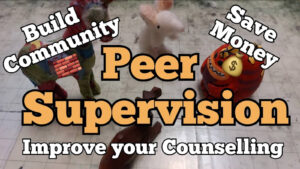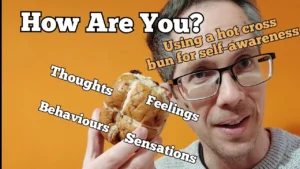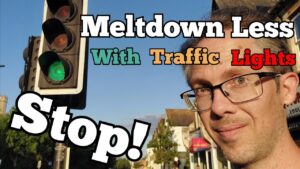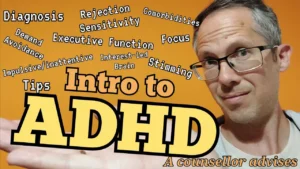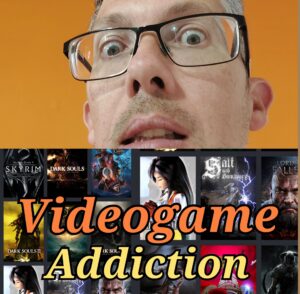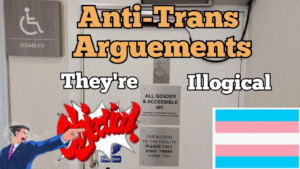Contents
Using a Hot Crossed Bun for Self-Awareness
How are you?
It’s a difficult question to answer and a question that you might answer differently if you’re asked in the supermarket vs if a loved one asks you.
My aim in this article is to support you to be able to answer that question for yourself, by improving your ability to check in with you, and I want to do that using a Hot Crossed Bun.
Hot Crossed Bun
So this model comes from CBT and is a way of breaking down our experience into individual components of Thoughts, Feelings, Behaviours, and Sensations. It doesn’t have to just be a CBT thing though – it’s just a way of conceptualising your experience.
You are the Hot Crossed Bun
A very small minority of people will be very comfortable with that question. They notice several feelings at play, nuances, complicated interplay of emotions that are informing them on their state in this moment. And that will help them to get an understanding of what they’re thinking and how they’re behaving.
This person with high emotional intelligence and likely had a pretty secure attachment growing up. As a baby, when they were sad and they were crying, mum would look them in the eye, see they were upset, and comfort them.
When they were angry and frustrated, that would be mirrored back to them. They would be cooled from their anger.
When they smiled, mum would smile back at them. There’d be a sense that their feelings are respected, mirrored, and not anything to be feared. Most of the time, those caregivers would be reliable people that they could depend on.
To make things even nicer for our theoretical person who is in flow with their emotions, they have had an easy life where they have not suffered oppression. There’s no sense of conditionality in how they grew up. They weren’t bullied in school. There is no one telling them ‘this is how you need to behave’. They have been able to flow their whole life through, and because of that they trust their feelings. They might have had a lot of therapy and they are really in touch with themselves and not a lot of bad has really happened to them or when it has they’ve got the resilience to get through it. They’re neurotypical, have no trauma, and no mental health problems.
Pause
So before we progress, pause for a second, perhaps start a two minute timer on your watch, and ask yourself “how do I feel right now”?
> Do I notice any thoughts in my mind? What are they about, how do I experience my thoughts, what’s the nature of them in this moment, are they welcomed?
> What feelings am I experiencing? How strong are they, what quality do they possess, do I feel them in a certain place, what is my judgement of those feelings?
> Are there any body sensations I am aware of? Posture? Pain, discomfort, the breath, any tension, perhaps a numbness in the body? Internal processes vs external, any things I am sensing like sounds?
> How am I behaving right now? What am I doing, what is my attitude like in doing this? Does a thought of another behaviour intrude that wants evaluating.
So let’s get into those different parts of our Hot Crossed Bun
Thoughts
Different people think in different ways – usually either more visually or verbally.
Some people think in words, some people internally hear an inner narration (with a distinctive voice), some people think more in images, some think in a more intuitive emotional way or recognising patterns. My point is, that the way you experience thought is likely different to how I do.
There will also be different types of thought:
the background narrative of passive thoughts that bounce around in your mind, the deep reflective thoughts where you hold into things and really consider, the thoughts that interact with other quadrants of the hot crossed bun judging those quadrants and responding to them. There will be thoughts that have originated creatively from you, thoughts that are pretty core or that you’ve introjected from others in your life like parents or from societal norms you’ve picked us as a child. There will be core beliefs that you unconsciously fight to reinforce, and opinions that drift by.
You are not your thoughts though. Our brains think and continually make meaning, and we can very much experience our selves as our thoughts but they are not always true, objective, or even us. One of the foundational benefits of Mindfulness is becoming an observer of our thoughts, as in doing do we can notice them and the quality of them rather than our thoughts dictating who we are. We can also notice an inner critic, and in being aware of it speaking, we can challenge it and give ourselves more compassion – recognising that critic is trying to protect us but doing it like a drill sergeant.
So this is the first quadrant – using our thoughts to check in with ourselves. Noticing what they are, observing them arising rather than being ruled by them, noticing their quality (loud or quiet, judgemental or observant, nice or critical, deep or lighter), and being able to question those thoughts and redirect them to be kinder to ourselves.
Feelings
If you’ve ever seen one of those Feeling Wheels you’ll recognise that there can be a lot of complexity and nuance talking about feelings, and some people will be very much in touch with theirs and feel multiple feelings at once.
Feeling wheels often start with an inner circle of the core emotions: anger, sadness, disgust, joy, fear, surprise; which then get ever more complicated and divide as layers increase e.g. sadness dividing into 6 other feelings such as despair which then divides into another two traits such as powerlessness.
In my experience, most people are less in contact with the nuances of their feelings. This is something Rogers talked about at the beginning of a therapeutic process – that most people will not be in touch with their feelings, and especially not organically with the flow of them; but this emotional fluency is very much the end process of therapy. Contact with feelings can also be challenging if we are neurodivergent (alexithymia), have grown up with limiting conditions on us, or have been exposed to trauma. In addiction, substances may numb our feelings and numbness (or denial), is also a common stage in the grieving process where people do not feel, and in depression we might feel numb.
Feelings are also individual – the word anxiety, for example, we may imagine we know what that means when someone describes it, but that same feeling could feel very different and be accompanied with different sensations and thoughts for each individual. All feelings are, however we label them, is a collection of impulses and sensations that we label fear whereas another might label that same experience excitement.
So, in writing this I want to say that t’s okay if you’re not mega in touch with your feelings and it’s okay if being in touch with them feels vulnerable and overwhelming. It’s a valid ‘in’ to your experience, but there are other ways. I also want to say that you can increase your emotional literacy – we tend to learn how to feel by parents helping us recognise those feelings, and in the process of therapy it can aid us in gaining language for our feelings.
Behaviours
The first two parts make up our internal reality – we might visibly display tells of our thoughts and feelings, but behaviours are very much the external expression of our experience and often how we are judged.
Behaviours can be quite active e.g. making myself a sandwich, more subtle like when I stim by playing with my hair, or even about our state of behaviour e.g. if I’m on auto pilot of actively aware of myself.
In his 19 Propositions, Carl Rogers described behaviours as
“the goal directed attempt of the organism to satisfy its needs as perceived in the field as perceived and the best vantage point for understanding behaviour is from the internal frame of the reference of the individual”
i.e. they make sense from our perspective and are need driven, even the ones that we feel guilty about or disprove of.
Just like we are not our thoughts, we are also not our behaviours yet they are part of us and we can look at them to better understand ourselves. This distinction can help around guilt and accountability. We take responsibility for the impacts of our behaviours, making amends where applicable and appropriate, but recognising that the way we behave isn’t always conscious or totally our fault and self-awareness of the needs being met in it can give us that control over it and loosen self-blame.
To add to the thing around behaviours not being our fault, you may well find you behave differently in different settings and take on roles within certain groups (like a parent, vulnerable child, an entertainer, a stern leader, a professor….) – behaving or acting that role without choice or awareness. We can likewise give ourselves permission to be aware of that role we are playing and see if we can shift it. The field of roles is such a big area that there’s a whole school of counselling that focusses on it (such as Transactional Analysis).
Sensations
Sensations are around what we sense within and outside of the body. With eating, for example, we may have sensations of the smell of the food, multifaceted elements of taste, the texture as we chew it, the way the throat wants to swallow, or the churning as the stomach anticipates the hot crossed bun and produces digestive enzymes and juices.
Body Sensations are what are physically going on in the body. Our senses are a real way of being able to get in contact with what’s happening and we also might experience our feelings in parts of the body pain for example maybe there’s a muscle or headache when we are tense and stressed. When I am fearful or excited, I often feel it in the bowel. The body can physically hold the affects of emotions and trauma within the body – to make that more relatable, stress heightens cortisol levels which suppress the immune system and leave you more susceptible to common colds, or most dopamine is produced in the gut. There’s no brain-body divide, our sensations are part of us and we can check in with ourselves using the body.
As a counsellor, my own body sensations can echo clients’, for example a client is calmly talking about their parents but for some reason my leg won’t start shaking and as I notice that I realise I am experience their unspoken sense of fear.
In recent years, Mindfulness based CBT programs have become popular due to their effectiveness. Someone experiencing depression may find their feelings are either too intense or numb and inaccessible, they may have anxiety accompanying their depression and their thoughts are racing and overwhelming, their may be shame around behaviours (why do I comfort eat, why have I got no energy?) and it feels as though these other three quadrants are inaccessible.
Well sensations can feel that bit more accessible without the judgement of the others, we can notice the breath to ground us, we can become aware of whether our teeth are clenched or shoulders hunched, we can notice dissociation if it’s held within the eyes.
Mindfulness’s goal is to help us to become a passive observer of ourselves without judgement
Disclaimer: Mindfulness isn’t a cure all, and just as the other quadrants aren’t appropriate for all, mindfulness can be too intense e.g. if we have trauma responses in the body, or sensory processing differences make things too loud, or focussing on tinnitus can make it louder.
Summary
We are not split into quadrants like a Hot Crossed Bun. We’re more like a hot crossed bun with 4 ingredients, and any of those ingredients can be used to better understand the bun.
Nonetheless, using those quadrants: Sensations, Behaviours, Feelings and Thoughts, can help us to better understand ourselves in a compassionate way that respects how we experience the world.
Simon is a Person-Centred Counsellor in Oxford working remotely and in person. He has lived in the county his whole life, and the city for almost 20 years. He appreciates the beauty of the city, nature, and connecting with people to help bring about meaningful change.
He is also a geek – who gets tremendous joy from gaming, crafting, cosplay, and creativity


